Spatial and Temporal Distribution of Aerosol Optical Depth and Its Relationship with Urbanization in Shandong Province
Abstract
:1. Introduction
2. Study Area, Materials, and Methodology
2.1. Study Area
2.2. Materials
2.2.1. Aerosol Data
2.2.2. Urbanization Related Data
2.2.3. Shandong Digital Elevation Model Data
2.3. Methodology
3. Results and Analysis
3.1. Temporal and Spatial Distribution and Variation Characteristics of AOD
3.1.1. Annual Average Distribution and Variation Characteristics of AOD
3.1.2. AOD Quarterly Average Distribution and Variation Characteristics
3.1.3. AOD Monthly Average Distribution and Variation Characteristics
3.2. Response Analysis of AOD to Social and Economic Factors
3.3. Response Analysis of AOD to Terrain and Weather Conditions
3.4. Analysis of AOD’s Response to the Urbanization Process
4. Conclusions
Author Contributions
Funding
Acknowledgments
Conflicts of Interest
References
- Cai, K.; Zhang, Q.S.; Li, S.S.; Li, Y.J.; Ge, W. Spatial-temporal variations in NO2 and PM2.5 over the chengdu-Chongqing Economic zone in China during 2005–2015 based on satellite remote sensing. Sensors 2018, 18, 3950. [Google Scholar] [CrossRef] [PubMed]
- Tsai, Y.I.; Kou, S.C.; Lee, W.J.; Chen, C.L.; Chen, P.T. Long-term visibility trends in one highly urbanized, one highly industrialized, and two rural areas of Taiwan. Sci. Total Environ. 2007, 382, 324–341. [Google Scholar] [CrossRef] [PubMed]
- Chow, J.C.; Watson, J.G.; Shah, J.J.; Kiang, C.S.; Loh, C.; Lev-On, M.; Lents, J.M.; Molina, M.J.; Molina, L.T. Megacities and atmospheric pollution. J. Air Waste Manag. Assoc. 2004, 54, 1226–1235. [Google Scholar] [CrossRef] [PubMed]
- Murena, F. Measuring air quality over large urban areas: Development and application of an air pollution index at the urban area of Naples. Atmos. Environ. 2004, 38, 6195–6202. [Google Scholar] [CrossRef]
- Singh, N.; Banerjee, T.; Raju, M.P.; Deboudt, K.; Sorek-Hamer, M.; Singh, R.S.; Mall, R.K. Aerosol chemistry, transport, and climatic implications during extreme biomass burning emissions over the Indo-Gangetic plain. Atmos. Chem. Phys. 2018, 18, 14197–14215. [Google Scholar] [CrossRef]
- Semoutnikova, E.G.; Gorchakov, G.I.; Sitnov, S.A.; Kopeikin, V.M.; Karpov, A.V.; Gorchakova, I.A.; Ponomareva, T.Y.; Isakov, A.A.; Gushchin, R.A.; Datsenko, O.I. Siberian smoke haze over European territory of Russia in July 2016: Atmospheric pollution and radiative effects. Atmos. Oceanic Opt. 2018, 31, 171–180. [Google Scholar] [CrossRef]
- Streets, D.G.; Yan, F.; Chin, M.; Diehl, T.; Mahowald, N.; Schultz, M.; Wild, M.; Wu, Y.; Yu, C.; Forschungszentrum. Anthropogenic and natural contributions to regional trends in aerosol optical depth, 1980–2006. J. Geophysi. Res. Atmos. 2009, 114, D00D18. [Google Scholar] [CrossRef]
- Zhao, Y.; Wang, S.; Duan, L.; Lei, Y.; Cao, P.; Hao, J. Primary air pollutant emissions of coal-fired power plants in China: Current status and future prediction. Atmos. Environ. 2008, 42, 8442–8452. [Google Scholar] [CrossRef]
- Streets, G.D.; Waldhoff, S.T. Present and future emissions of air pollutants in China: SO2, NOx, and CO. Atmos. Environ. 2000, 34, 363–374. [Google Scholar] [CrossRef]
- Li, Z.; Feng, N.; Fan, J.; Liu, Y.; Rosenfeld, D.; Ding, Y. Long-term impacts of aerosols on the vertical development of clouds and precipitation. Nat. Geosci. 2011, 4, 888–894. [Google Scholar] [CrossRef]
- Sesé, L.; Nunes, H.; Cottin, V.; Sanyal, S.; Didier, M.; Carton, Z.; Israelbiet, D.; Crestani, B.; Cadranel, J.; Wallaert, B. Role of atmospheric pollution on the natural history of idiopathic pulmonary fibrosis. Thorax 2017, 73. [Google Scholar] [CrossRef] [PubMed]
- Agarwal, K.S.; Mughal, M.Z.; Upadhyay, P.; Berry, J.L.; Mawer, E.B.; Puliyel, J.M. The impact of atmospheric pollution on vitamin D status of infants and toddlers in Delhi, India. Arch. Dis. Child. 2002, 87, 111. [Google Scholar] [CrossRef] [PubMed]
- Yang, M.; Ding, R.; Wang, S.; Shang, K. The Geological calamity and rainstorm intensity in Lanzhou city. Arid Meteorol. 2005, 23, 54–57. [Google Scholar] [CrossRef]
- Kaiser, D.P.; Qian, Y. Decreasing trends in sunshine duration over China for 1954–1998: Indication of increased haze pollution? Geophys. Res. Lett. 2002, 29, 2042. [Google Scholar] [CrossRef]
- Wild, M.; Gilgen, H.; Roesch, A.; Ohmura, A.; Long, C.N.; Dutton, E.G.; Forgan, B.; Kallis, A.; Russak, V.; Tsvetkov, A. From dimming to brightening: Decadal changes in solar radiation at Earth’s surface. Science 2005, 308, 847–850. [Google Scholar] [CrossRef] [PubMed]
- Zheng, X.; Kang, W.; Zhao, T.; Luo, Y.; Duan, C.; Chen, J. Long-term trends in sunshine duration over Yunnan-Guizhou Plateau in Southwest China for 1961–2005. Geophys. Res. Lett. 2008, 35, 386–390. [Google Scholar] [CrossRef]
- Rosenfeld, D.; Dai, J.; Yu, X.; Yao, Z.; Xu, X.; Yang, X.; Du, C. Inverse relations between amounts of air pollution and orographic precipitation. Science 2007, 315, 1396–1398. [Google Scholar] [CrossRef] [PubMed]
- Zhang, X.Y. Aerosol over China and their climate effect. Adv. Earth Sci. 2007, 22, 12–16. [Google Scholar] [CrossRef]
- Shi, G.; Wang, B.; Zhang, H.; Zhao, J.; Tan, S.; Wen, T. The radiative and climatic effects of atmospheric aerosols. Chin. J. Atmos. Sci. 2008, 32, 826–840. [Google Scholar]
- Ma, J.H.; Zheng, Y.F.; Zhang, H. The optical depth global distribution of black carbon aerosol and its possible reason analysis. Scientia Meteorologica Logica Sinica 2007, 27, 549–556. [Google Scholar] [CrossRef]
- Shan, N.; Yang, X.H.; Shi, Z.J.; Yan, F. Spatial and temporal distribution of aerosol optical depth in China based on MODIS. Sci. Soil Water Conserv. 2012, 10, 24–30. [Google Scholar] [CrossRef]
- Zeng, Q.; Chen, L.; Zhu, H.; Wang, Z.; Wang, X.; Zhang, L.; Gu, T.; Zhu, G.; Zhang, Y. Satellite-based estimation of hourly PM2.5 Concentrations using a vertical-humidity correction method from Himawari-AOD in Hebei. Sensors 2018, 18, 3456. [Google Scholar] [CrossRef] [PubMed]
- Aaron, V.D.; Martin, R.V.; Michael, B.; Ralph, K.; Robert, L.; Carolyn, V.; Villeneuve, P.J. Global estimates of ambient fine particulate matter concentrations from satellite-based aerosol optical depth: Development and application. Environ. Health Perspect. 2010, 118, 847–855. [Google Scholar]
- Yang, J.M.; Qiu, J.H.; Zhao, Y.L. Validation of aerosol optical depth from terra and aqua MODIS retrievals over a Tropical Coastal Site in China. Atmos. Oceanic Sci. Lett. 2010, 3, 36–39. [Google Scholar] [CrossRef]
- Wang, L.; Xin, J.; Wang, Y.; Li, Z.; Liu, G.; Li, J. Evaluation of the MODIS aerosol optical depth retrieval over different ecosystems in China during EAST-AIRE. Atmos. Environ. 2007, 41, 7138–7149. [Google Scholar] [CrossRef]
- Wang, P.; Ning, S.J.; Dai, J.G.; Sun, J.M.; Lv, M.J.; Song, Q.L.; Dai, X.; Zhao, J.R.; Yu, D. Trends and variability in aerosol optical depth over North China from MODIS C6 aerosol products during 2001–2016. Atmosphere 2017, 8, 223. [Google Scholar] [CrossRef]
- Buseck, P.R.; Pósfai, M. Airborne minerals and related aerosol particles: Effects on climate and the environment. Proc. Natl. Acad. Sci. USA 1999, 96, 3372–3379. [Google Scholar] [CrossRef] [PubMed] [Green Version]
- Li, J.W.; Han, Z.W. Numerical simulation of the seasonal variation of aerosol optical depth over eastern China. J. Remote Sens. 2016, 20, 205–215. [Google Scholar] [CrossRef]
- Zheng, X.B.; Lou, Y.X.; Chen, J. Climatology of aerosol optical depth over China from recent 10 years of MODIS remote sensing data. Ecol. Environ. Sci. 2012, 32, 265–272. [Google Scholar]
- Zheng, X.B.; Lou, Y.X.; Zhao, T.L.; Chen, J.; Kang, W.M. Geographical and climatological characterization of aerosol distribution in China. Scientia Geographica Sinica 2012, 32, 876–883. [Google Scholar] [CrossRef]
- Duan, Q.; Mao, J.T. Study on the distribution and variation trends of atmospheric aerosol optical depth over the Yangtze River Delta. Acta Scientiae Circumstantiae 2007, 27, 537–543. [Google Scholar] [CrossRef]
- Su, W.H.; Shen, J.; Zhang, Q.P.; Yin, X.J.; Song, W.Z.; Lu, H.R.; Liu, J.Y.; Yuan, J.W.; Zheng, X.H.; Shen, S.Z. A study of air pollution and aerosol sulfate in the region of Tianjin. Acta Scientiae Circumstantiae 1982, 2, 329–341. [Google Scholar] [CrossRef]
- He, L.J.; Wang, L.C.; Lin, A.W.; Zhang, M.; Xia, X.G.; Tao, M.H.; Zhou, H. What drives changes in aerosol properties over the Yangtze River Basin in past four decades? Atmos. Environ. 2018, 190, 269–283. [Google Scholar] [CrossRef]
- Sogacheva, L.; Rodriguez, E.; Kolmonen, P.; Virtanen, T.H.; Saponaro, G.; de Leeuw, G.; Georgoulias, A.K.; Alexandri, G.; Kourtidis, K.; van der A, R.J. Spatial and seasonal variations of aerosols over China from two decades of multi-satellite observations—Part 2: AOD time series for 1995–2017 combined from ATSR ADV and MODIS C6.1 and AOD tendency estimations. Atmos. Chem. Phys. 2018, 18, 16631–16652. [Google Scholar] [CrossRef]
- Zhao, X.; Gao, Q.; Sun, M.; Xue, Y.; Ma, R.; Xiao, X.; Ai, B. Statistical analysis of spatiotemporal heterogeneity of the distribution of air quality and dominant air pollutants and the effect factors in Qingdao Urban Zones. Atmosphere 2018, 9, 135. [Google Scholar] [CrossRef]
- Li, L.; Chen, J.; Wang, L.; Melluki, W.; Wahid; Zhou, H. Aerosol single scattering albedo affected by chemical composition: An investigation using CRDS combined with MARGA. Atmos. Res. 2013, 124, 149–157. [Google Scholar] [CrossRef]
- Wang, M.X. Aerosols in relation to climate change. Clim. Environ. Res. 2000, 5, 1–5. [Google Scholar] [CrossRef]
- Sun, J.R.; Liu, Y. Possible effect of aerosols over china on east asian summer monsoon (I): Sulfate aerosols. Adv. Clim. Chang. Res. 2008, 4, 53–58. [Google Scholar] [CrossRef]
- Jiang, Y. The Mode analysis of law on the prevention and control of atmospheric pollution: From the illegal punishment to environmental quality objective. J. Beijing For. Uni. 2017, 16, 34–42. [Google Scholar] [CrossRef]
- Jacobson, M.Z. Atmospheric pollution—History, science, and regulation. Phys. Today 2003, 56, 65–66. [Google Scholar] [CrossRef]
- Rowntree, P.R. The influence of tropical east Pacific Ocean temperatures on the atmosphere. Q. J. R. Meteorol. Soc. 2010, 98, 290–321. [Google Scholar] [CrossRef]
- Deng, Z.C.; Sun, Y.L.; Zhou, H.; Song, R.X. A study on quantification of environmental capacity of marine ecology in coastal area—Qingdao city. Marine Environ. Sci. 2009, 28, 438–441. [Google Scholar] [CrossRef]
- Jickells, T. Emissions from the Oceans to the Atmosphere, Deposition from the Atmosphere to the Oceans and the Interactions between Them. In Global Change—The IGBP; Springer: Berlin/Heidelberg, Germany, 2001; pp. 93–96. [Google Scholar] [CrossRef]
- Li, C.C.; Mao, J.Y.; Liu, Q.H.; Chen, J.Z.; Yuan, Z.B.; Liu, X.Y.; Zhu, A.H.; Liu, G.Q. Using MODIS to study the distribution and seasonal variation of aerosol optical thickness in eastern China. Chin. Sci. Bull. 2003, 48, 2094–2100. [Google Scholar] [CrossRef]
- Van, T.T.; Hai, N.H.; Bao, V.Q.; Bao, H.D.X. Remote Sensing-Based Aerosol Optical Thickness for Monitoring Particular Matter over the City. Proceedings 2018, 2, 362. [Google Scholar] [CrossRef]
- Wei, J.; Lin, S. Comparison and evaluation of different MODIS aerosol optical depth products over the Beijing-Tianjin-Hebei region in China. IEEE J. Sel. Topics Appl. Earth Obs. Remote Sens. 2017, 99, 1–10. [Google Scholar] [CrossRef]

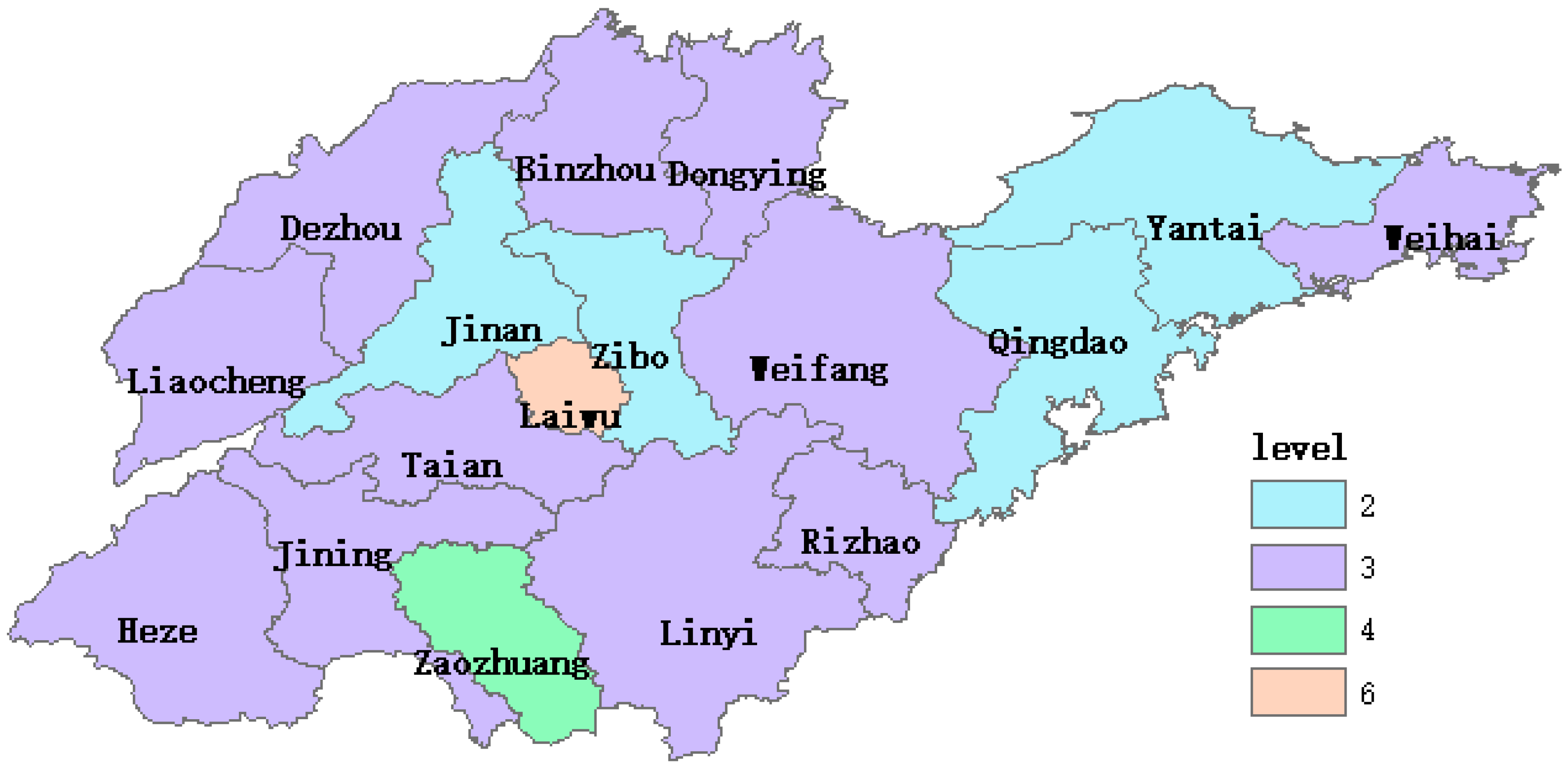

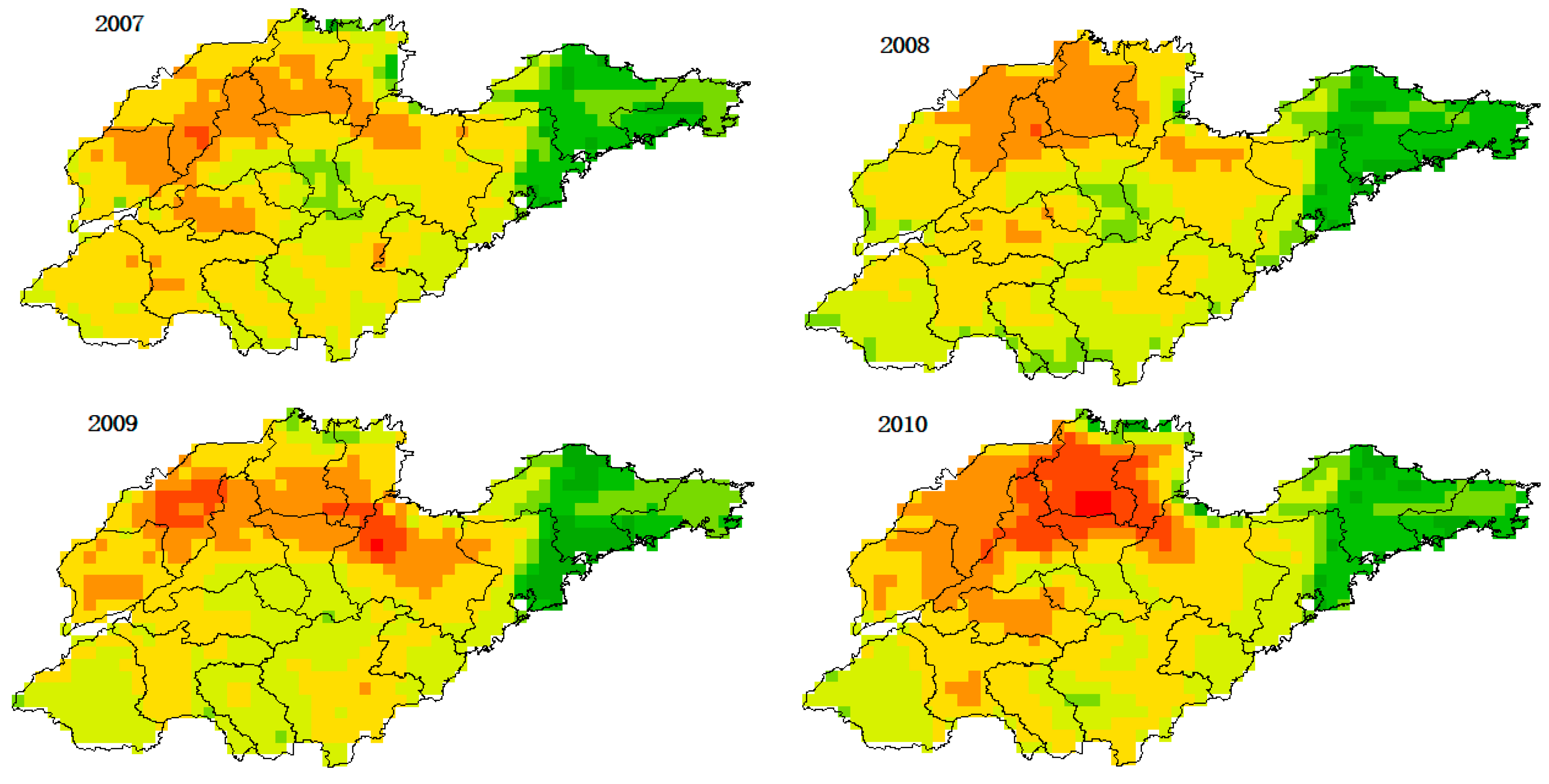
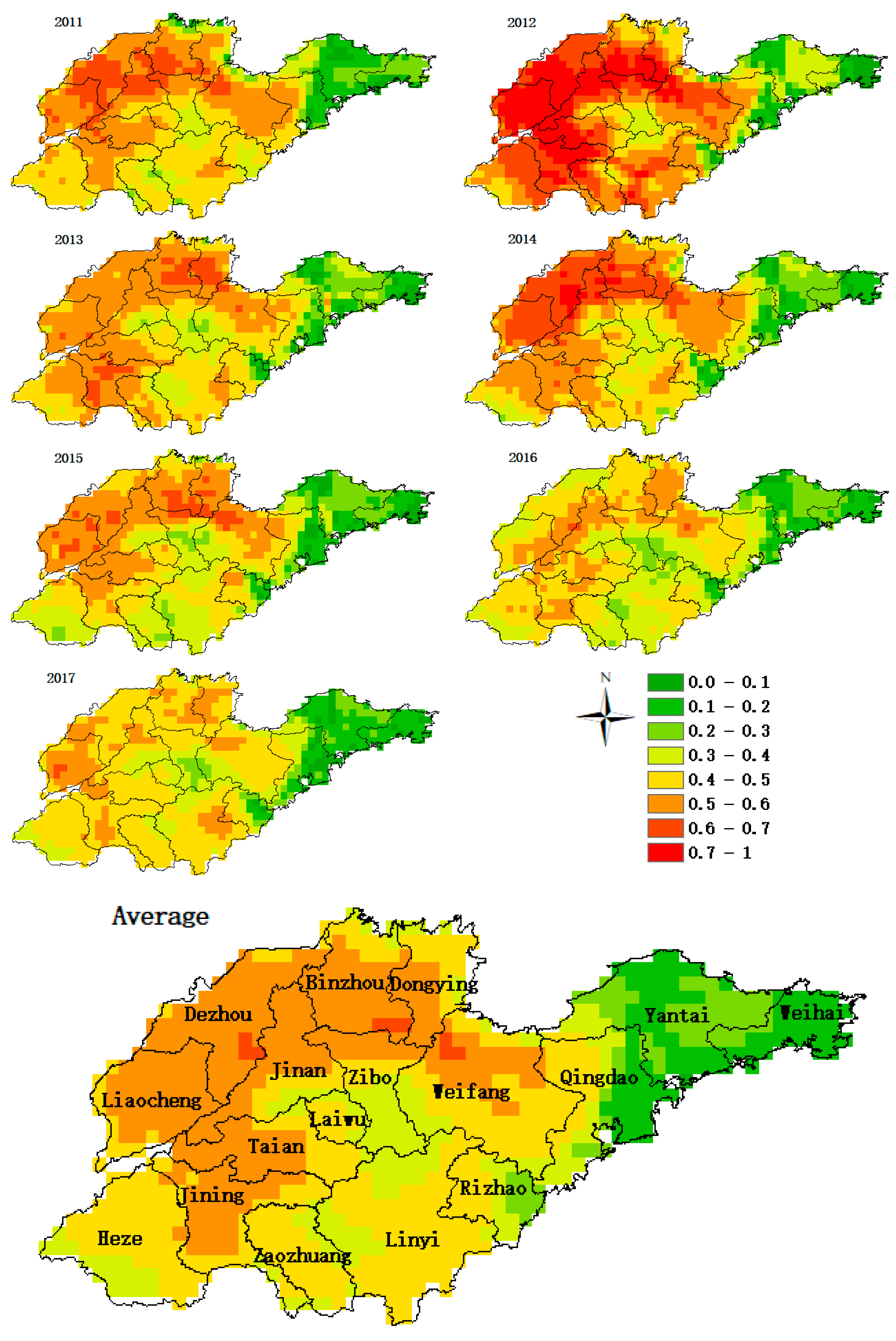

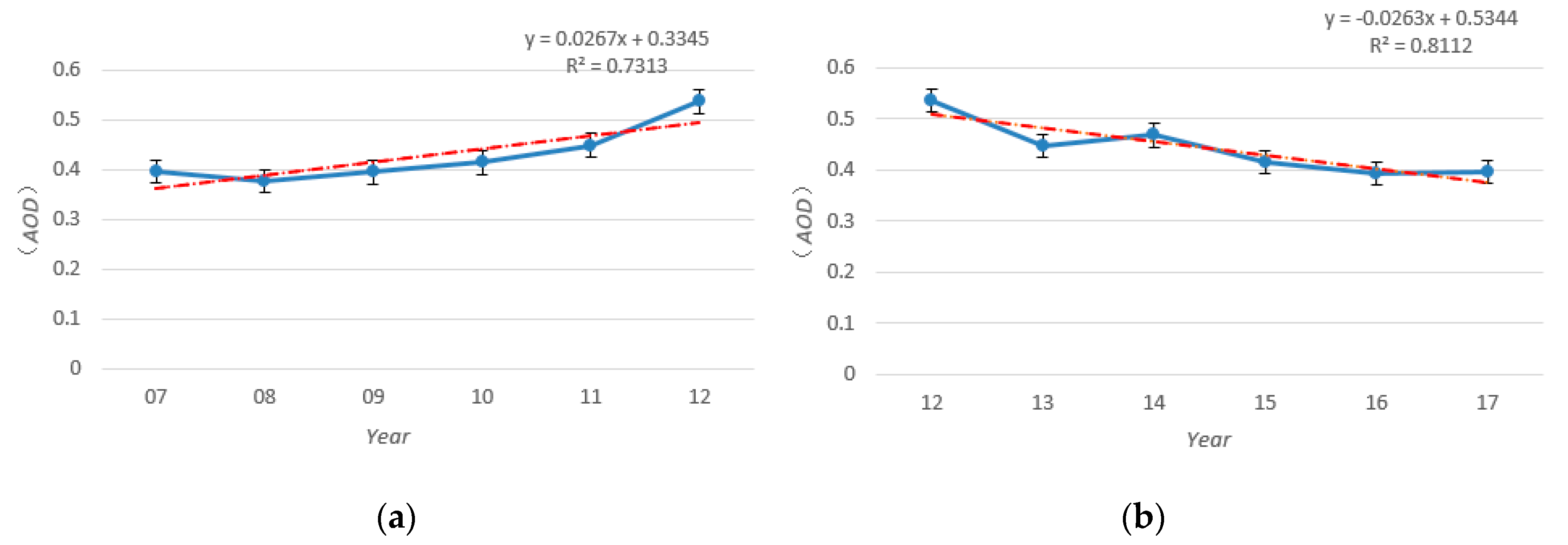
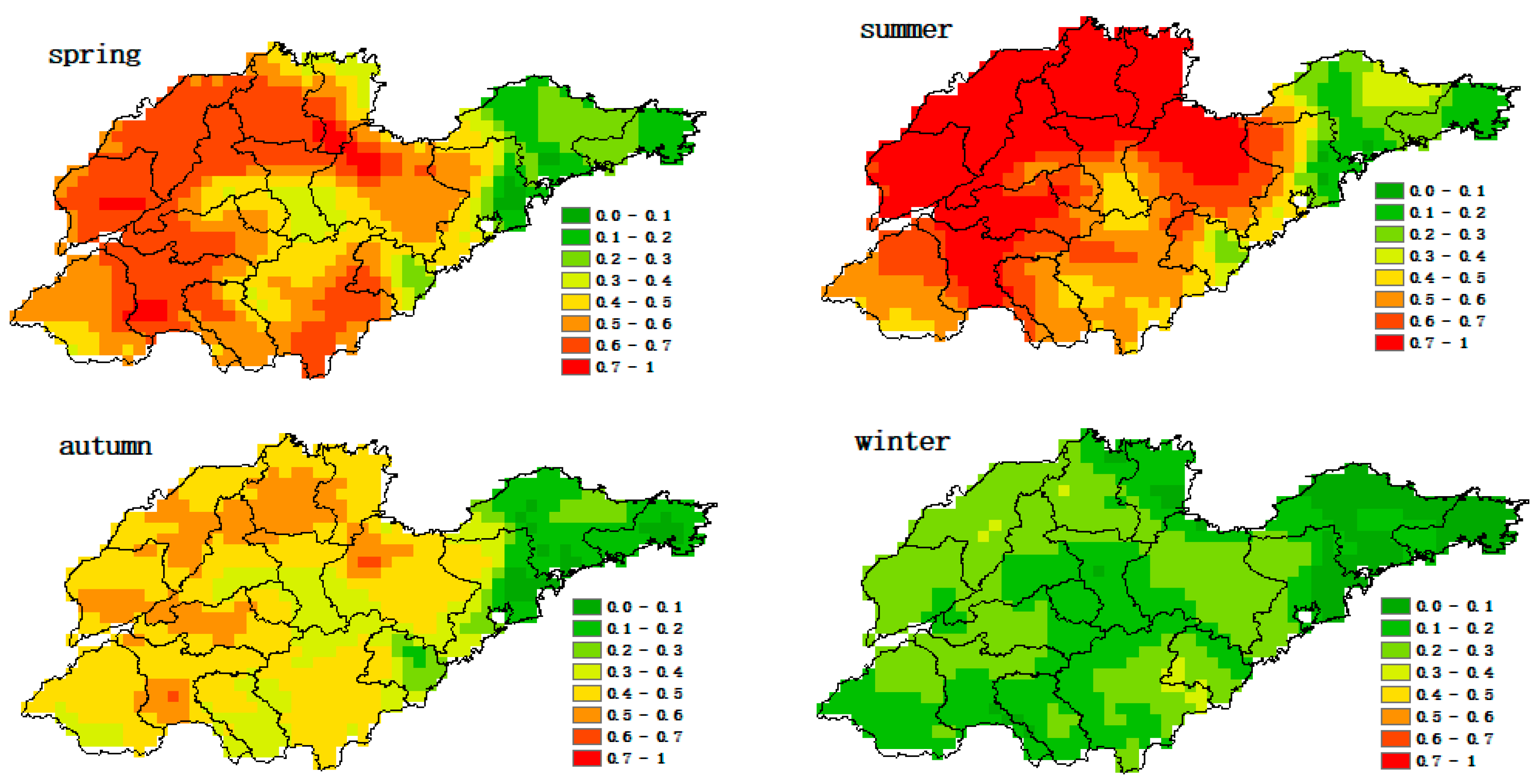

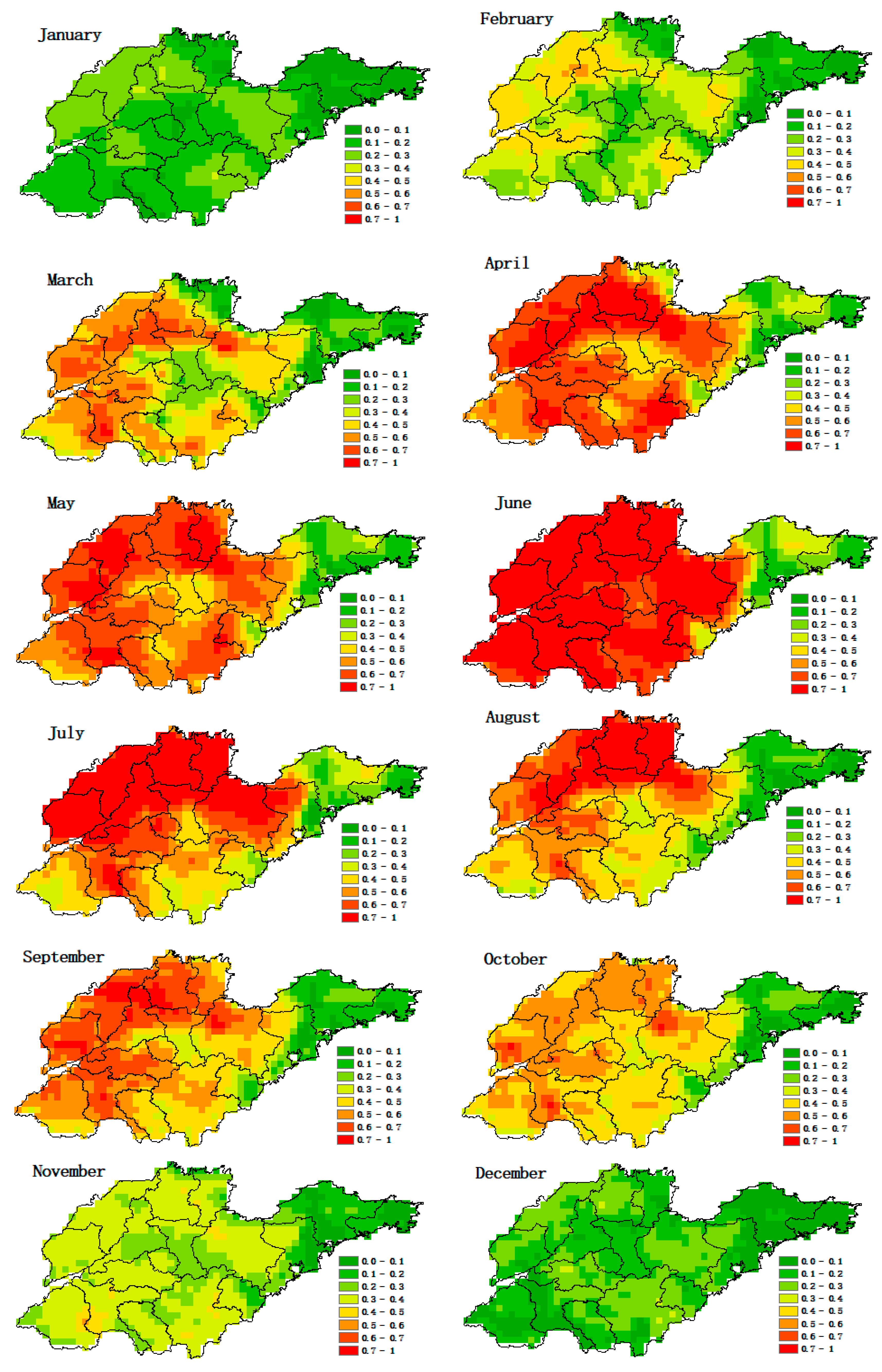
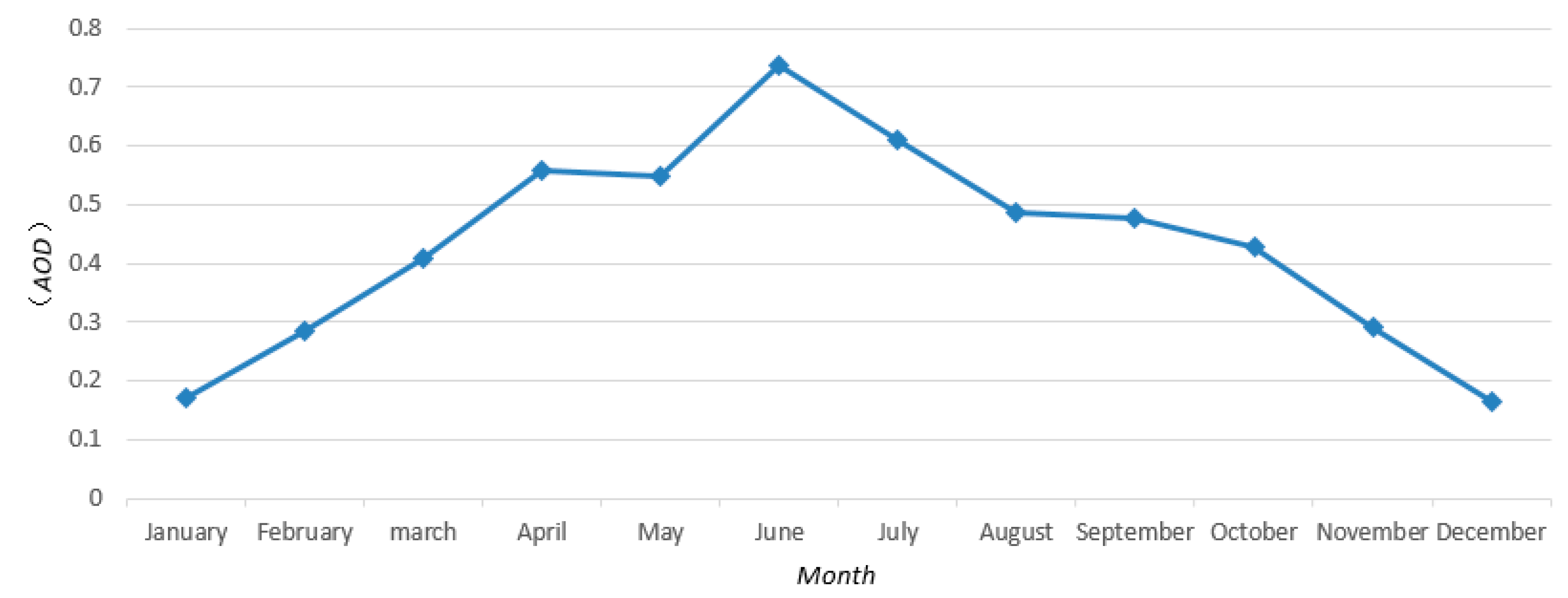
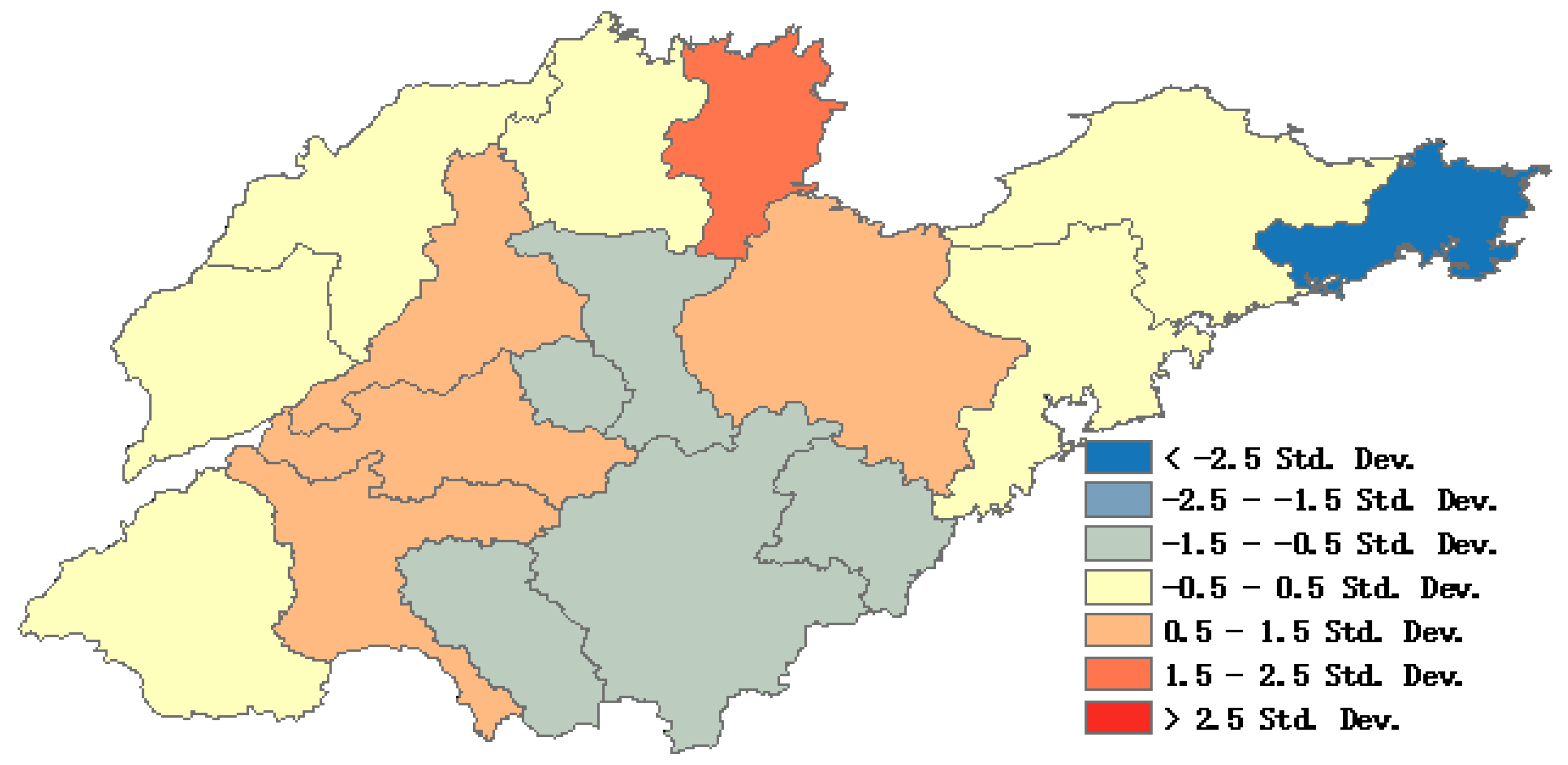
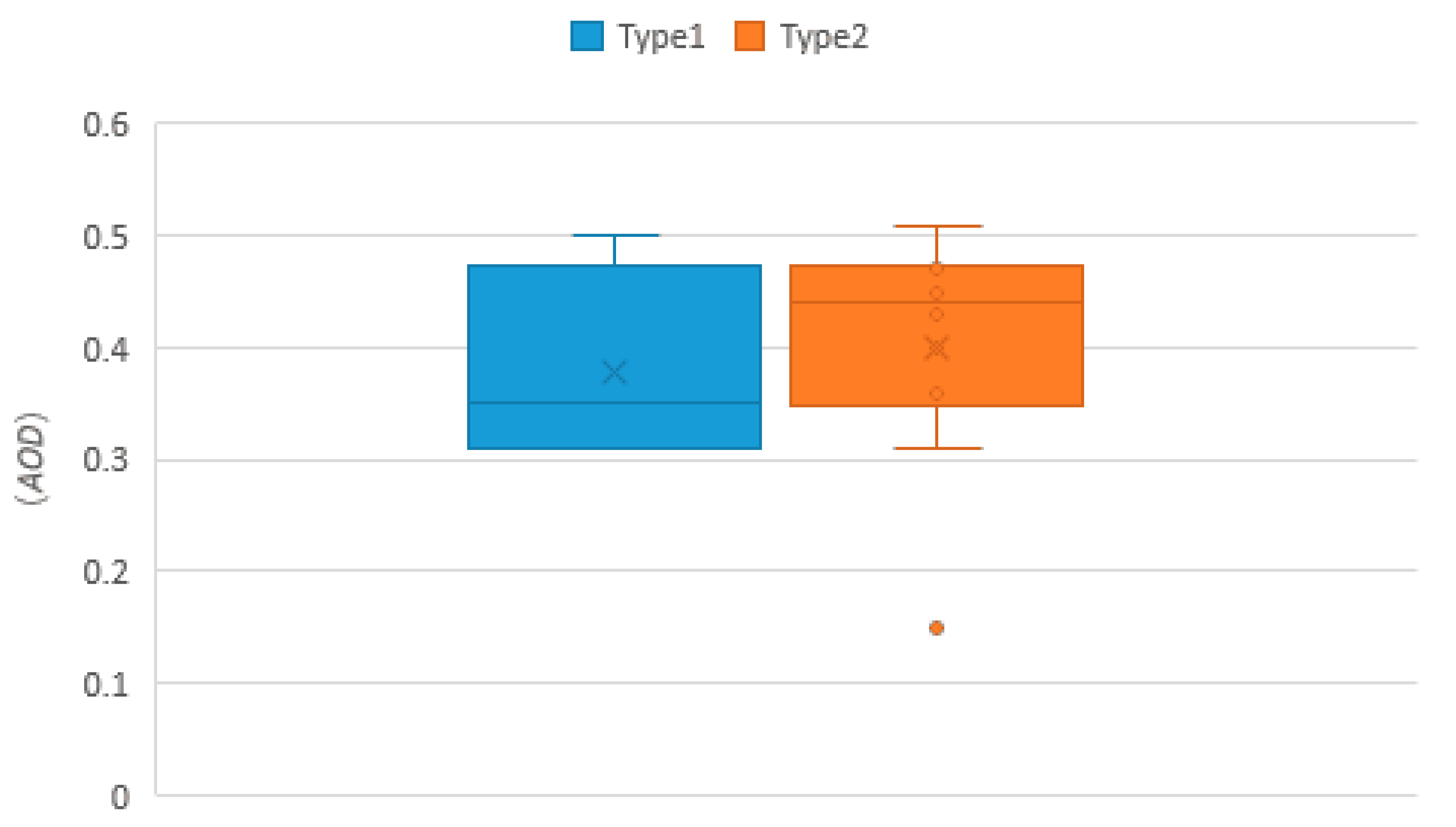
| Year | AOD | Population (10,000 people) | Green Land Area (ha) | Secondary Industry Regional GDP (100,000,000 Yuan) | Soot (10,000 T) | SO2 (10,000 T) | Nitrogen Oxides (10,000 T) |
|---|---|---|---|---|---|---|---|
| 2007 | 0.3960 | 3436 | 146,076 | 14,839.13 | 46 | 182 | |
| 2008 | 0.3769 | 3532 | 156,957 | 17,839.09 | 44 | 169 | |
| 2009 | 0.3955 | 3548 | 168,408 | 19,219.83 | 42 | 159 | 138 |
| 2010 | 0.4140 | 3839 | 181,055 | 22,163.00 | 39 | 154 | 141 |
| 2011 | 0.448 | 3945 | 188,136 | 24,539.45 | 78 | 183 | 179 |
| 2012 | 0.5363 | 4021 | 199,899 | 26,367.57 | 70 | 175 | 174 |
| 2013 | 0.4475 | 4130 | 217,366 | 28,163.57 | 70 | 164 | 165 |
| 2014 | 0.4673 | 4285 | 232,174 | 29,585.72 | 121 | 159 | 159 |
| 2015 | 0.4153 | 4702 | 240,024 | 30,334.56 | 108 | 153 | 142 |
| 2016 | 0.3916 | 4856 | 253,328 | 31,343.67 | 87 | 113 | 123 |
| 2017 | 0.3962 | 5024 | 267,944 | 32,942.84 | 54 | 74 | 116 |
| Factor | Population | Greening Land Area | Secondary Industry Regional GDP | Soot | Nitrogen Oxides | |
|---|---|---|---|---|---|---|
| AOD | 0.191 | 0.21 | 0.21 | 0.393 | 0.329 | 0.867 |
| Factor | DEM | Temperature | Precipitation |
|---|---|---|---|
| AOD | −0.430 | 0.585 | 0.341 |
© 2019 by the authors. Licensee MDPI, Basel, Switzerland. This article is an open access article distributed under the terms and conditions of the Creative Commons Attribution (CC BY) license (http://creativecommons.org/licenses/by/4.0/).
Share and Cite
Xue, R.; Ai, B.; Lin, Y.; Pang, B.; Shang, H. Spatial and Temporal Distribution of Aerosol Optical Depth and Its Relationship with Urbanization in Shandong Province. Atmosphere 2019, 10, 110. https://doi.org/10.3390/atmos10030110
Xue R, Ai B, Lin Y, Pang B, Shang H. Spatial and Temporal Distribution of Aerosol Optical Depth and Its Relationship with Urbanization in Shandong Province. Atmosphere. 2019; 10(3):110. https://doi.org/10.3390/atmos10030110
Chicago/Turabian StyleXue, Rui, Bo Ai, Yaoyao Lin, Beibei Pang, and Hengshuai Shang. 2019. "Spatial and Temporal Distribution of Aerosol Optical Depth and Its Relationship with Urbanization in Shandong Province" Atmosphere 10, no. 3: 110. https://doi.org/10.3390/atmos10030110





